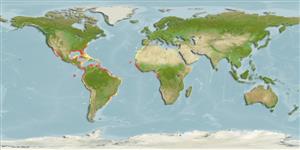Classification / Names
Common names from other countries
Main reference
Size / Weight / Age
Max length : 430 cm TL male/unsexed; (Ref. 96339); common length : 304 cm TL male/unsexed; (Ref. 247); max. published weight: 109.6 kg (Ref. 40637); max. reported age: 25 years (Ref. 72467)
Length at first maturity
Lm ?, range 230 - 240 cm
Environment
Marine; brackish; reef-associated; depth range 0 - 130 m (Ref. 43278), usually 1 - 35 m (Ref. 40849)
Climate / Range
Subtropical, preferred 27°C (Ref. 107945); 44°N - 35°S, 122°W - 10°E (Ref. 247)
Distribution
Short description
Dorsal
spines
(total): 0. Moderately long barbels, nasoral grooves present but no perinasal grooves, mouth well in front of eyes, spiracles minute, precaudal tail shorter than head and body, dorsal fins broadly rounded (the first much larger than the second and anal fins), caudal fin moderately long, over 1/4 of total length, yellow-brown to grey-brown in color, with or without small dark spots and obscure dorsal saddle markings (Ref. 247). Head blunt, mouth inferior, pair of conspicuous barbels between nostrils (Ref. 26938).
IUCN Red List Status (Ref. 115185)
Threat to humans
Traumatogenic (Ref. 4690)
Human uses
Fisheries: minor commercial; aquarium: public aquariums
Tools
Special reports
Download XML
Internet sources
Estimates of some properties based on models
Phylogenetic diversity index
PD50 = 0.8125 many relatives (e.g. carps) 0.5 - 2.0 few relatives (e.g. lungfishes)
Trophic Level
4.2 ±0.2 se; Based on diet studies.
Resilience
Low, minimum population doubling time 4.5 - 14 years (K=0.14; tmax=25; Fec=21-28)
Vulnerability
Very high vulnerability (81 of 100)
Price category
